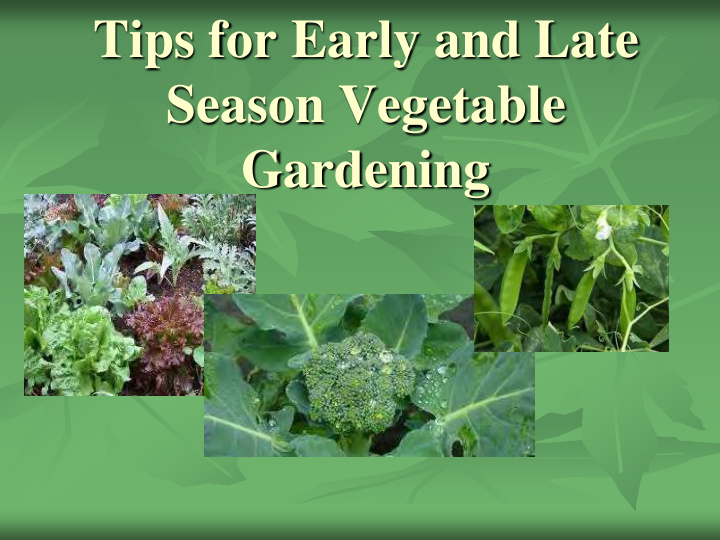



Tips for Early and Late Season Vegetable Gardening
Today’s Focus: Direct seeding or transplanting vegetables for spring and fall vegetable gardens Low input approach: raised beds and/or containers, organic methods and good soil stewardship (including cover crops and companion planting) Site selection (beds or containers) Succession planting/season extension Resources
Benefits of Spring Vegetable Gardening Pleasant weather = high enthusiasm Fewer weeds/insects/diseases (not animals!) More sunlight/less canopy Less watering Your own “spring” vegetables on demand including PEAS
Good Soils: The basis for healthy plants Soil Texture: Sand/Silt/Clay Soil Structure: Aggregates protect organic matter. Organic matter builds aggregates. Soil Biology and Chemistry: Good soil management fosters diverse soil biology and active soil chemistry which increases resilience and nutrient availability
Soil Textural Triangle
Soil Aggregates
It’s Elemental! (and molecular)
“The Basic Process of Life” Plants feed themselves* and the soil * carbohydrates only
The Soil Food Web
Site Selection Beds or Containers? Bright Sun Leaf Vegetables: 4 hours Root Vegetables: 6 hours Fruiting Vegetables: 8+ hours Good Drainage
Raised Rows, Beds, Boxes (No Till) (Rows = compaction)
Containers: Many Choices
Containers continued…
Make a Plan: Think about general layout, succession and interplanting Formal or informal
Fill Boxes/Containers with quality soil/media
Soil Test
Soil pH and Nutrient Availability
What will you grow? So many choices! Catalogs and seed packets are a great source of information. Choose what you like, and what is practical for your space and your needs
A note on organic seeds Why choose organic seeds? Sustainability and non-GMO Some sources High Mowing Seeds, Cook’s Garden, Seeds of Change Many traditional seed companies now offer organic seeds (Park, Johnny’s, Burpees)
Start Planting
Starting Seeds Indoors/ Pre-germinating
Vegetables you can plant today and eat within 8 weeks Arugula, Asian Greens, Carrots*, Chives, Collards, Kale, Lettuces, Mustard Greens, Peas, Radishes, Spinach, Chard *Carrots take more like 10-12 weeks. Google: Zone 7 Planting Guide
Companion Planting Mechanisms: ● Impart desired characteristics (e.g. acidity, N fixation) ● Repellants to insects and animals (fragrance) ● Trap Plants (nasturtiums/aphids) ● Attract beneficial insects (flowers) ● Maximize season/root zone (interplant) ● Provide structure or shade (corn) ● Bring nutrients from soil depth (perennial grains)
Companion Planting http://www.almanac.com/content/plant- companions-list-ten-common-vegetables
Enjoy your spring, summer harvest and then…
Thinking Ahead: Intercropping & Succession Planting Take advantage of “spaces” in the garden, both physical and seasonal Maximize yield and interest Build soil health through plant variety/diversity
Thinking ahead: Season Extenders For production in early spring, late fall or even over winter
Thinking ahead: Season Extenders (cont’d) Cold Frames/Hot Beds
Thinking ahead: Cover Crops Bare soils are unproductive and release carbon into the atmosphere as CO 2 , contributing to global warming. Cover crops keep carbon in the soil and also: Retain soil and minimize erosion/water runoff Legumes Fix N in the soil Foster mycorrhizal fungi Reduce compaction/increase aeration Suppress weeds Add soil organic matter Attract beneficial insects/pollinators
Best Cover Crops for Northeast Gardens* Spring: Clovers, Buckwheat, Hairy Vetch Late Summer: Oats/Peas mixture, Buckwheat *Note: Rye, though recommended, can be very invasive and hard to control, as well as allelopathic *www.gardening.cornell/edu/factsheets/ecogardening/impsoil.html
Legumes “fix” Nitrogen Symbiotic relationship between bacteria and plant Nodules house bacteria that transform N 2 gas into plant available NO 3 - and NH 4 +
Continuous Cover (cont’d) Arbuscular Mycorrhizal Fungi A symbiosis between fungus and root (80% of all plants have it) AMF hyphae produces glomalin, a glycoprotein that h elps create stable soil aggregates (structure)
If using fertilizer, choose the right one. (Nutrients only available in solution)
One last thing… Consider necessary barriers
Plant something/anything today! (You’ll be glad you did.) Seeds or seedlings out now in beds or containers Pre-germinate seeds indoors Later… Interplant summer crops in May Sow/plant successively throughout summer Sow fall crops in late July
Happy Spring Gardening! Virginia Lamb Groundwork Education and Consulting 347-262-0704 vlamb@groundworkec.com
Recommend
More recommend